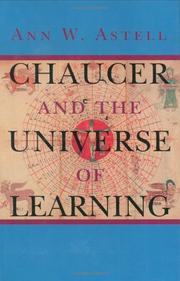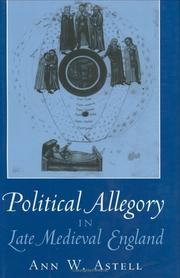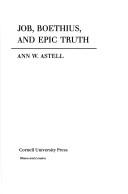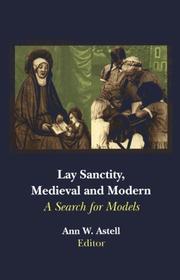| Listing 1 - 10 of 23 | << page >> |
Sort by
|

ISBN: 9780801444661 0801444667 1501704559 1501704540 1501704346 Year: 2006 Publisher: Ithaca, N.Y. Cornell University Press
Abstract | Keywords | Export | Availability | Bookmark
 Loading...
Loading...Choose an application
- Reference Manager
- EndNote
- RefWorks (Direct export to RefWorks)
"The enigmatic link between the natural and artistic beauty that is to be contemplated but not eaten, on the one hand, and the eucharistic beauty that is both seen (with the eyes of faith) and eaten, on the other, intrigues me and inspires this book. One cannot ask theo-aesthetic questions about the Eucharist without engaging fundamental questions about the relationship between beauty, art (broadly defined), and eating."-from Eating BeautyIn a remarkable book that is at once learned, startlingly original, and highly personal, Ann W. Astell explores the ambiguity of the phrase "eating beauty." The phrase evokes the destruction of beauty, the devouring mouth of the grave, the mouth of hell. To eat beauty is to destroy it. Yet in the case of the Eucharist the person of faith who eats the Host is transformed into beauty itself, literally incorporated into Christ. In this sense, Astell explains, the Eucharist was "productive of an entire 'way' of life, a virtuous life-form, an artwork, with Christ himself as the principal artist." The Eucharist established for the people of the Middle Ages distinctive schools of sanctity-Cistercian, Franciscan, Dominican, and Ignatian-whose members were united by the eucharistic sacrament that they received. Reading the lives of the saints not primarily as historical documents but as iconic expressions of original artworks fashioned by the eucharistic Christ, Astell puts the "faceless" Host in a dynamic relationship with these icons. With the advent of each new spirituality, the Christian idea of beauty expanded to include, first, the marred beauty of the saint and, finally, that of the church torn by division-an anti-aesthetic beauty embracing process, suffering, deformity, and disappearance, as well as the radiant lightness of the resurrected body. This astonishing work of intellectual and religious history is illustrated with telling artistic examples ranging from medieval manuscript illuminations to sculptures by Michelangelo and paintings by Salvador Dalí. Astell puts the lives of medieval saints in conversation with modern philosophers as disparate as Simone Weil and G. W. F. Hegel.
Art --- Christian dogmatics --- anno 500-1499 --- Lord's Supper --- Aesthetics --- Food --- Spiritual life --- Eucharistie --- Esthétique --- Aliments --- Vie spirituelle --- Catholic Church --- History of doctrines --- Religious aspects --- Catholic Church. --- Eglise catholique --- Histoire des doctrines --- Aspect religieux --- -Lord's Supper --- -Aesthetics --- -Food --- -Spiritual life --- -265.3 --- Life, Spiritual --- Religious life --- Spirituality --- Foods --- Dinners and dining --- Home economics --- Table --- Cooking --- Diet --- Dietaries --- Gastronomy --- Nutrition --- Beautiful, The --- Beauty --- Esthetics --- Taste (Aesthetics) --- Philosophy --- Criticism --- Literature --- Proportion --- Symmetry --- Communion --- Eucharist --- Holy Communion --- Sacrament of the Altar --- Blood --- Sacraments --- Sacred meals --- Last Supper --- Mass --- -History of doctrines --- -Catholic Church --- -Religious aspects --- -Eucharistie --- Psychology --- Christianity --- 265.3 Eucharistie --- Esthétique --- 265.3 --- Religious aspects&delete& --- Radio broadcasting Aesthetics

ISBN: 0801432693 Year: 1996 Publisher: Ithaca London Cornell University Press
Abstract | Keywords | Export | Availability | Bookmark
 Loading...
Loading...Choose an application
- Reference Manager
- EndNote
- RefWorks (Direct export to RefWorks)
Astrologie dans la littérature --- Astrologie in de literatuur --- Astrology in literature --- Christelijke bedevaarders en bedevaarten in de literatuur --- Christian pilgrims and pilgrimages in literature --- Connaissance [Théorie de la ] dans la littérature --- Cosmologie médiévale dans la littérature --- Cosmology [Medieval ] in literature --- Epistemologie in de literatuur --- Epistemology in literature --- Epistémologie dans la littérature --- Filosofie [Middeleeuwse ] in de literatuur --- Kenleer in de literatuur --- Kennisleer in de literatuur --- Kennistheorie in de literatuur --- Kentheorie in de literatuur --- Knowledge [Theory of ] in literature --- Kosmologie [Middeleeuwse ] in de literature --- Philosophie médiévale dans la littérature --- Philosophy [Medieval ] in literature --- Pèlerins et pèlerinages chrétiens dans la littérature --- Théorie de la connaissance dans la littérature --- 113 --- Algemene natuurwetten. Oorsprong van de wereld. Schepping. Kosmogonie --- Philosophy Cosmology --- 113 Algemene natuurwetten. Oorsprong van de wereld. Schepping. Kosmogonie --- Chaucer, Geoffrey --- Knowledge and learning --- Learning and scholarship --- History --- Medieval, 500-1500 --- Chaucer, Geoffrey, - d. 1400 - Knowledge and learning. --- Cosmology, Medieval, in literature. --- Middle Ages, 500-1500 --- Chaucer (geoffrey), d. 1400 --- Cosmology in literature --- Medieval philosophy in literature

ISBN: 0801435609 0801474655 Year: 1999 Publisher: Ithaca London Cornell University Press
Abstract | Keywords | Export | Availability | Bookmark
 Loading...
Loading...Choose an application
- Reference Manager
- EndNote
- RefWorks (Direct export to RefWorks)
Ann W. Astell here affords a radically new understanding of the rhetorical nature of allegorical poetry in the late Middle Ages. She shows that major English writers of that era-among them, William Langland, John Gower, Geoffrey Chaucer, and the Gawain-poet-offered in their works of fiction timely commentary on current events and public issues. Poems previously regarded as only vaguely political in their subject matter are seen by Astell to be highly detailed and specific in their veiled historical references, implied audiences, and admonitions. Astell begins by describing the Augustinian and Boethian rhetorical principles involved in the invention of allegory. She then compares literary and historical treatments of key events in fourteenth- and fifteenth-century England, finding an astonishing match of allusions and code words, especially those deriving from puns, titles, heraldic devices, and personal cognizances, as well as repeated proverbs, prophecies, and exempla. Among the works she discusses are John Ball's Letters and parts of Piers Plowman, which she presents as two examples of allegorical literature associated with the Peasants' Revolution of 1381; Gower's allegorical representation of the Merciless Parliament of 1388 in Confessio Amantis; and Chaucer's brilliant literary handling of key events in the reign of Richard II. In addition Astell argues for a precise dating of Sir Gawain and the Green Knight between 1397 and 1399 and decodes the work as a political allegory.
Allegorie --- Allegory --- Allégorie --- Inventio (Retorica) --- Invention (Rhetoric) --- Invention (Rhétorique) --- Medieval rhetoric --- Middeleeuwse retorica --- Retorica [Middeleeuwse ] --- Rhetoric [Medieval ] --- Rhétorique médiévale --- English literature --- Political poetry, English (Middle) --- Politics and literature --- Rhetoric, Medieval. --- Allegory. --- Personification in literature --- Symbolism in literature --- Rhetoric --- English political poetry, Middle --- Middle English political poetry --- Political poetry, English --- Political poetry, Middle English --- English poetry --- History and criticism. --- History --- Great Britain --- Politics and government --- Rhetoric, Medieval --- History and criticism --- Middle English, 1100-1500 --- Political poetry [English ] (Middle) --- To 1500 --- 1154-1399 --- 1399-1485

ISBN: 0801429110 1501743171 1501733257 1501743163 Year: 2019 Publisher: Cornell University Press
Abstract | Keywords | Export | Availability | Bookmark
 Loading...
Loading...Choose an application
- Reference Manager
- EndNote
- RefWorks (Direct export to RefWorks)
Calling into question the common assumption that the Middle Ages produced no secondary epics, Ann W. Astell here revises a key chapter in literary history. She examines the connections between the Book of Job and Boethius' s Consolation of Philosophy-texts closely associated with each other in the minds of medieval readers and writers-and demonstrates that these two works served as a conduit for the tradition of heroic poetry from antiquity through the Middle Ages and into the Renaissance. As she traces the complex influences of classical and biblical texts on vernacular literature, Astell offers provocative readings of works by Dante, Chaucer, Spenser, Malory, Milton, and many others. Astell looks at the relationship between the historical reception of the epic and successive imitative forms, showing how Boethius's Consolation and Johan biblical commentaries echo the allegorical treatment of" epic truth" in the poems of Homer and Virgil, and how in turn many works classified as "romance" take Job and Boethius as their models. She considers the influences of Job and Boethius on hagiographic romance, as exemplified by the stories of Eustace, Custance, and Griselda; on the amatory romances of Abelard and Heloise, Dante and Beatrice, and Troilus and Criseyde; and on the chivalric romances of Martin of Tours, Galahad, Lancelot, and Redcrosse. Finally, she explores an encyclopedic array of interpretations of Job and Boethius in Milton's Paradise Lost, Paradise Regained, and Samson Agonistes.
Epic literature --- Imitation in literature. --- Influence (Literary, artistic, etc.) --- Literary form --- Literature, Medieval --- Typology (Theology) in literature --- Quotation --- Literary style --- Mimesis in literature --- Originality in literature --- Plagiarism --- Artistic impact --- Artistic influence --- Impact (Literary, artistic, etc.) --- Literary impact --- Literary influence --- Literary tradition --- Tradition (Literature) --- Art --- Influence (Psychology) --- Literature --- Intermediality --- Intertextuality --- European literature --- Medieval literature --- History and criticism&delete& --- Theory, etc --- History --- Classical influences --- Boethius, --- Bible. --- Biblia --- Bible --- Ayyūb (Book of the Old Testament) --- Giobbe (Book of the Old Testament) --- Hiob (Book of the Old Testament) --- Ijob (Book of the Old Testament) --- Iobus (Book of the Old Testament) --- Iov (Book of the Old Testament) --- Iyov (Book of the Old Testament) --- Iyyov (Book of the Old Testament) --- Job (Book of the Old Testament) --- Jobus (Book of the Old Testament) --- Livro de Jó --- Yop-ki (Book of the Old Testament) --- Criticism, interpretation, etc. --- In literature. --- Typology (Theology) in literature. --- Classical influences. --- History and criticism --- Theory, etc. --- Imitation in literature --- Literary studies: ancient, classical & medieval

ISBN: 0268013306 9780268013301 0268013322 9780268013325 Year: 2000 Publisher: Notre Dame (Ind.): University of Notre Dome Press,
Abstract | Keywords | Export | Availability | Bookmark
 Loading...
Loading...Choose an application
- Reference Manager
- EndNote
- RefWorks (Direct export to RefWorks)
Inspired by Vatican II, which attributed a special apostolate to the laity and affirmed their calling to holiness, this volume of original essays focuses on the shifting points of intersection between changing historical definitions of laity and sanctity. Ann W. Astell and ten other scholars examine a series of medieval and modern lay "saints" in order to explore how these figures perceived their own lay status and how this status has been perceived by others.
Laity --- Christian saints --- Catholic Church --- History of doctrines --- Religious life --- History --- 235*4 --- 260.2 --- Christian laity --- Laymen --- Church polity --- Lay ministry --- Saints --- Canonization --- 260.2 De Kerk: de gelovigen --- De Kerk: de gelovigen --- 235*4 Heiligheid--(theologische aspecten) --- Heiligheid--(theologische aspecten) --- Catholic Church&delete& --- Religious life&delete& --- Laity - Catholic Church - History of doctrines --- Laity - Religious life - History --- Sainteté laïque

ISBN: 9780801482670 9780801423475 Year: 1995 Publisher: Ithaca, N.Y. Cornell University Press
Abstract | Keywords | Export | Availability | Bookmark
 Loading...
Loading...Choose an application
- Reference Manager
- EndNote
- RefWorks (Direct export to RefWorks)
Christian spirituality --- Old French literature --- anno 500-1499
Book
ISBN: 9780268106218 9780268106249 9780268106232 0268106215 0268106231 026810624X Year: 2020 Publisher: Notre Dame, Indiana
Abstract | Keywords | Export | Availability | Bookmark
 Loading...
Loading...Choose an application
- Reference Manager
- EndNote
- RefWorks (Direct export to RefWorks)
Hailed in Sacred Scripture as the "beginning of wisdom" (Ps 111:10), the "fear of the Lord" is seldom mentioned and little understood today. A gift of the Spirit and a moral virtue or disposition, the "fear of the Lord" also frequently entails emotional experiences of differing kinds: compunction, dread, reverence, wonderment, and awe. Starting with the Bible itself, this collection of seventeen essays explores the place of holy fear in Christian spirituality from the early church to the present and argues that this fear is paradoxically linked in various ways to fear's seeming opposite, love. Indeed, the charged dynamic of love and fear accounts for different experiences and expressions of Christian life in response to changing historical circumstances and events.The writings of the theologians, mystics, philosophers, saints, and artists studied here reveal the relationship between the fear and the love of God to be profoundly challenging and mysterious, its elements paradoxically conjoined in a creative tension with each other, but also tending to oscillate back-and-forth in the history of Christian spirituality as first one, then the other, comes to the fore, sometimes to correct a perceived imbalance, sometimes at the risk of losing its companion altogether. Given this historical pattern, clearly evident in these chronologically arranged essays, the palpable absence of a discourse of holy fear from the mainstream theological landscape should give us pause and invite us to consider if and how--under what aspect, in which contexts--a holy fear, inseparable from love, might be regained or discovered anew within Christian spirituality as a remedy both for a crippling anxiety and for a presumptive recklessness. This book will be of interest to students and scholars of Christian spirituality, theology, biblical studies, religious studies, and religion and literature.
Christian theology --- Fear of God --- Fear --- Christianity --- Religious aspects&delete& --- Christianity. --- Religious aspects

ISBN: 0801423473 1501720694 0801482674 Year: 1990 Publisher: Ithaca Cornell university press
Abstract | Keywords | Export | Availability | Bookmark
 Loading...
Loading...Choose an application
- Reference Manager
- EndNote
- RefWorks (Direct export to RefWorks)
The author examines medieval reader response, both interpretive and imitative, to the Song of Songs. Disputing the common view that the literal meaning of Canticles had no value for medieval readers, she points to 12th-century commentaries on the Song, as well as an array of Middle English works, as evidence that the Song's sensuous imagery played an essential part in its tropological appeal.
Literature, Medieval --- History and criticism --- Bible. --- Biblia --- Criticism, interpretation, etc. --- History --- In literature. --- Medieval & Renaissance Studies. --- Religious Studies. --- History and criticism. --- Bible
Book
ISBN: 0268106231 Year: 2020 Publisher: Notre Dame, Indiana : University of Notre Dame Press,
Abstract | Keywords | Export | Availability | Bookmark
 Loading...
Loading...Choose an application
- Reference Manager
- EndNote
- RefWorks (Direct export to RefWorks)
Hailed in Sacred Scripture as the "beginning of wisdom" (Ps 111:10), the "fear of the Lord" is seldom mentioned and little understood today. A gift of the Spirit and a moral virtue or disposition, the "fear of the Lord" also frequently entails emotional experiences of differing kinds: compunction, dread, reverence, wonderment, and awe. Starting with the Bible itself, this collection of seventeen essays explores the place of holy fear in Christian spirituality from the early church to the present and argues that this fear is paradoxically linked in various ways to fear's seeming opposite, love. Indeed, the charged dynamic of love and fear accounts for different experiences and expressions of Christian life in response to changing historical circumstances and events.The writings of the theologians, mystics, philosophers, saints, and artists studied here reveal the relationship between the fear and the love of God to be profoundly challenging and mysterious, its elements paradoxically conjoined in a creative tension with each other, but also tending to oscillate back-and-forth in the history of Christian spirituality as first one, then the other, comes to the fore, sometimes to correct a perceived imbalance, sometimes at the risk of losing its companion altogether. Given this historical pattern, clearly evident in these chronologically arranged essays, the palpable absence of a discourse of holy fear from the mainstream theological landscape should give us pause and invite us to consider if and how--under what aspect, in which contexts--a holy fear, inseparable from love, might be regained or discovered anew within Christian spirituality as a remedy both for a crippling anxiety and for a presumptive recklessness. This book will be of interest to students and scholars of Christian spirituality, theology, biblical studies, religious studies, and religion and literature.
Fear of God --- Fear --- Christianity. --- Religious aspects
Book
ISBN: 0809135280 Year: 1994 Publisher: New York (N.Y.): Paulist
Abstract | Keywords | Export | Availability | Bookmark
 Loading...
Loading...Choose an application
- Reference Manager
- EndNote
- RefWorks (Direct export to RefWorks)
Spirituality --- Postmodernism --- Religion and culture --- Religious aspects --- Christianity --- Mary, --- Theology.
| Listing 1 - 10 of 23 | << page >> |
Sort by
|

 Search
Search Feedback
Feedback About UniCat
About UniCat  Help
Help News
News